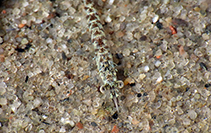Mysis gaspensis Tattersall, 1954
Classification / Names Common names | Synonyms | CoL | ITIS | WoRMS
Malacostraca | Mysida | Mysidae
Environment: milieu / climate zone / depth range / distribution range Ecology
Benthic; freshwater; brackish; depth range 0 - 2 m (Ref. 130981). Boreal
Distribution Countries | FAO areas | Ecosystems | Occurrences | Introductions
Northwest Atlantic: Canada and USA.
Length at first maturity / Size / Weight / Age
Maturity: Lm ?, range 1 - 1.65 cm Max length : 2 cm TL (female)
Life cycle and mating behavior Maturity | Reproduction | Spawning | Eggs | Fecundity | Larvae
Main reference
References | Coordinator | Collaborators
Dadswell, M.J. 2021 The distribution and life history of Mysis gaspensis O.S. Tattersall,1954 (Crustacea, Mysida): an almost endemic, nektonic component of Atlantic Canada estuarine and coastal ecosystems. Proceedings of the Nova Scotian Institute of Science 51(Part 2):327-345. (Ref. 130981)
IUCN Red List Status
(Ref. 130435: Version 2025-1)
CITES status (Ref. 108899)
CMS (Ref. 116361)
Threat to humans
Human uses
| FishSource |
Tools
More information
Diet composition
Food consumption
Predators
Max. ages / sizes
Length-weight rel.
Length-length rel.
Length-frequencies
Mass conversion
Abundance
Internet sources
BHL | BOLD Systems | CISTI | DiscoverLife | FAO(Publication : search) | Fishipedia | GenBank (genome, nucleotide) | GloBI | Gomexsi | Google Books | Google Scholar | Google | PubMed | Tree of Life | Wikipedia (Go, Search) | Zoological Record



